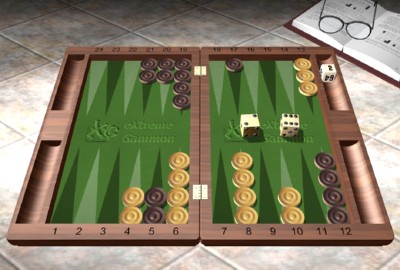Cash game. Black owns the cube. White on move.

White to play 6-2.
Extreme Gammon (XG) is the most useful tool ever invented for improving at backgammon. It’s both the strongest commercially available backgammon software, and, when used properly, the best teacher.
Getting the most out of XG’s teaching ability, however, requires a little thought and planning. In this post I’ll give an example of how using XG’s power, combined with a little critical thinking, can help you patch weak spots in your game.
Take a look at today’s position. White has escaped both his back checkers and made a couple of good points in the process. Black is holding onto White’s 5-point, playing what we call a basic 5-point holding game. White is trying to come home without leaving any shots. Last turn White doubled and Black correctly took.
Now White rolls 6-2. He can’t play safely off the midpoint, so he’s got a few choices. He can make the 2-point, breaking the 4-point but keeping plenty of spares available. He can start the 2-point with 8/2 6/4, keeping a better point but leaving himself with one less spare to move. And finally he can break the 10-point with 10/4 10/8.
Your play here depends on whether you think the 10-point is an asset or a liability. In general, when you’re trying to bring a position like this home your watchword is “Clear from the back”. Your back point here is the midpoint, so you’d like to clear that first. The 6, 8, and 10-points are all landing spots for the checkers on the midpoint, so they’re all assets right now.
When this position came up in a game of mine, that was my train of thought. “The 10-point is an asset because it helps me clear the midpoint, so I’ll use one of my spares and make the 2-point. I don’t care about the blot on the 4, because I’ll remake that later.” Very reasonable thinking.
But quite wrong.
The 10-point isn’t just an asset – it’s both an asset and a liability, all rolled into one. (A little like Kris Kristofferson’s Pilgrim – “a walking contradiction, partly truth and partly fiction.”) It’s an asset because it provides a landing spot for the midpoint checkers as they try to come home. But it’s a liability at the same time because it will have to be cleared later, and only 11 numbers clear the point – combinations of 2, 4, and 6, plus doubles except 5-5.
Now we’ve thrown a number that allows us to clear the point, so now we have to decide – is it more of an asset (in which case we want to keep it) or more of a liability (in which case we want to clear it)?
In this position, the answer is that it’s more of a liability. It only helps us when we throw precisely a 5-3 and clear the midpoint. But it hurts us when we need to clear it but can’t, and on any given turn 70% of our numbers won’t clear it without leaving a shot. So now our play is clear – get off the point with 10/8 10/4, and hope to play with our spares while we wait for a double to clear the midpoint.
Suppose instead of the 10-point we owned the 11-point or the 9-point. What would we do with a potential clearing number in those cases? The 11-point is even harder to clear than the 10-point, so if we threw a 5-3 we’d be delighted to clear it. But the 9-point is much easier to clear, so if we had the 9-point instead of the 10-point and threw something like a 6-3 or 6-5 we’d keep the point and dump checkers in our home board.





